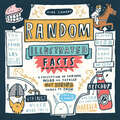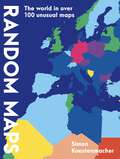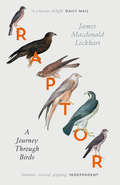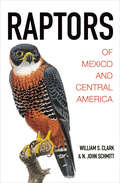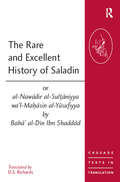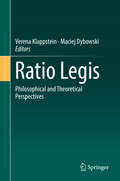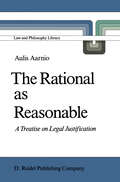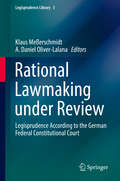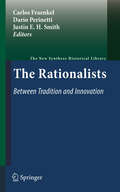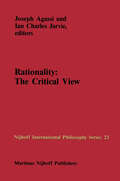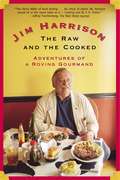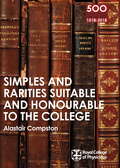- Table View
- List View
Random Illustrated Facts: A Collection of Curious, Weird, and Totally Not Boring Things to Know
by Mike LoweryDid you know that Napoleon was once attacked by rabbits? Or that the Mars Rover sang itself &“Happy Birthday&”? How about the odd ingredient Civil War soldiers used to make coffee?Trivia meets its match. From Jupiter&’s diamond showers to why pirates wore eye patches to the delightful link between dancing goats and the discovery of coffee, this collection of obscure and fascinating facts is brought to you by Mike Lowery, an illustrator and connoisseur of the offbeat. Featuring four gatefolds and hundreds of infographic webs that connect the trivia in dozens of surprising ways, it&’s a little book that delivers endless delight.
Random Maps: The World in Over 100 Unusual Maps
by Simon KuestenmacherWhat would the world be without maps? How would we orientate ourselves? How would we travel? How could we plan streets or entire cities? We encounter maps everywhere in everyday life. But they can do much more than just represent the topography of places.The geographer Simon Kuestenmacher collects exciting, entertaining and useful maps that open up a new perspective on the world in an extraordinary way. Where on Earth do most people live? What does the world look like from a dolphin's point of view? What did the world look like in the 17th century? Where in Europe were the last executions carried out? And how much tip is expected in the different countries?All maps represent our living environment in an unusual way, explain connections from new perspectives and show how much fun data and facts are when they are presented in a visually interesting way.
Raptor: A Journey Through Birds
by James Macdonald LockhartWinner of The Royal Society of Literature Jerwood Award for Non-Fiction in 2011 and the Authors' Foundation Roger Deakin Award in 2011 A stunning debut in the tradition of Robert Macfarlane and Helen Macdonald
Raptors of Mexico and Central America
by William S. Clark N. John Schmitt Lloyd KiffThe essential field guide to the raptors of Mexico and Central AmericaRaptors are among the most challenging birds to identify in the field due to their bewildering variability of plumage, flight silhouettes, and behavior. Raptors of Mexico and Central America is the first illustrated guide to the region's 69 species of raptors, including vagrants. It features 32 stunning color plates and 213 color photos, and a distribution map for each regularly occurring species. Detailed species accounts describe key identification features, age-related plumages, status and distribution, subspecies, molt, habitats, behaviors, potential confusion species, and more.Raptors of Mexico and Central America is the essential field guide to this difficult bird group and the ideal travel companion for anyone visiting this region of the world.Covers all 69 species of raptors found in Mexico and Central AmericaFeatures 32 color plates and hundreds of color photosProvides multiple illustrations of each speciesDepicts and describes variations in plumage by individual, morph, age, and regionDescribes behavior, food preferences, hunting strategies, vocalizations, and moltCovers rare and extralimital speciesIncludes distribution maps and flight silhouettes
Raptors of Mexico and Central America
by William S. Clark N. John Schmitt Lloyd KiffThe essential field guide to the raptors of Mexico and Central AmericaRaptors are among the most challenging birds to identify in the field due to their bewildering variability of plumage, flight silhouettes, and behavior. Raptors of Mexico and Central America is the first illustrated guide to the region's 69 species of raptors, including vagrants. It features 32 stunning color plates and 213 color photos, and a distribution map for each regularly occurring species. Detailed species accounts describe key identification features, age-related plumages, status and distribution, subspecies, molt, habitats, behaviors, potential confusion species, and more.Raptors of Mexico and Central America is the essential field guide to this difficult bird group and the ideal travel companion for anyone visiting this region of the world.Covers all 69 species of raptors found in Mexico and Central AmericaFeatures 32 color plates and hundreds of color photosProvides multiple illustrations of each speciesDepicts and describes variations in plumage by individual, morph, age, and regionDescribes behavior, food preferences, hunting strategies, vocalizations, and moltCovers rare and extralimital speciesIncludes distribution maps and flight silhouettes
The Rare and Excellent History of Saladin or al-Nawadir al-Sultaniyya wa'l-Mahasin al-Yusufiyya by Baha' al-Din Ibn Shaddad (Crusade Texts in Translation)
by Bahā’ al-Dīn Ibn ShaddādSaladin is perhaps the one and only Muslim ruler who emerges with any clarity in standard tales and histories of the Crusades; this is a translation of Baha’ al-Din Ibn Shaddad’s account of his life and career. Ibn Shaddad (1144-1234) was clearly a great admirer of Saladin and was a close associate of his, serving as his qadi al-’askar (judge of the army), from 1188 until Saladin’s death in 1193. His position and his access to information make this an authoritative and essential source for Saladin’s career, while his personal relationship with the sultan adds a sympathetic and moving element to the account of his final years. Aside from its inherent value as a source for the history of Egypt and the Middle East, it therefore provides a much-needed complement and corrective to the widely-known Latin accounts of the Crusades and the Latin Kingdom of Jerusalem in the 12th century. The present translation is based on a fuller edition of the text than that used in the previous 19th-century translation, and takes into account the translator’s readings of the earliest manuscript of the work, dated July 1228.
The Rare and Excellent History of Saladin or al-Nawadir al-Sultaniyya wa'l-Mahasin al-Yusufiyya by Baha' al-Din Ibn Shaddad (Crusade Texts in Translation)
by D. S. RichardsSaladin is perhaps the one and only Muslim ruler who emerges with any clarity in standard tales and histories of the Crusades; this is a translation of Baha’ al-Din Ibn Shaddad’s account of his life and career. Ibn Shaddad (1144-1234) was clearly a great admirer of Saladin and was a close associate of his, serving as his qadi al-’askar (judge of the army), from 1188 until Saladin’s death in 1193. His position and his access to information make this an authoritative and essential source for Saladin’s career, while his personal relationship with the sultan adds a sympathetic and moving element to the account of his final years. Aside from its inherent value as a source for the history of Egypt and the Middle East, it therefore provides a much-needed complement and corrective to the widely-known Latin accounts of the Crusades and the Latin Kingdom of Jerusalem in the 12th century. The present translation is based on a fuller edition of the text than that used in the previous 19th-century translation, and takes into account the translator’s readings of the earliest manuscript of the work, dated July 1228.
Rare Birds of North America
by Steve N. Howell Ian Lewington Will RussellRare Birds of North America is the first comprehensive illustrated guide to the vagrant birds that occur throughout the United States and Canada. Featuring 275 stunning color plates, this book covers 262 species originating from three very different regions--the Old World, the New World tropics, and the world's oceans. It explains the causes of avian vagrancy and breaks down patterns of occurrence by region and season, enabling readers to see where, when, and why each species occurs in North America. Detailed species accounts describe key identification features, taxonomy, age, sex, distribution, and status. Rare Birds of North America provides unparalleled insights into vagrancy and avian migration, and will enrich the birding experience of anyone interested in finding and observing rare birds. Covers 262 species of vagrant birds found in the United States and Canada Features 275 stunning color plates that depict every species Explains patterns of occurrence by region and season Provides an invaluable overview of vagrancy patterns and migration Includes detailed species accounts and cutting-edge identification tips
Rare Birds of North America
by Steve N. Howell Ian Lewington Will RussellRare Birds of North America is the first comprehensive illustrated guide to the vagrant birds that occur throughout the United States and Canada. Featuring 275 stunning color plates, this book covers 262 species originating from three very different regions--the Old World, the New World tropics, and the world's oceans. It explains the causes of avian vagrancy and breaks down patterns of occurrence by region and season, enabling readers to see where, when, and why each species occurs in North America. Detailed species accounts describe key identification features, taxonomy, age, sex, distribution, and status. Rare Birds of North America provides unparalleled insights into vagrancy and avian migration, and will enrich the birding experience of anyone interested in finding and observing rare birds. Covers 262 species of vagrant birds found in the United States and Canada Features 275 stunning color plates that depict every species Explains patterns of occurrence by region and season Provides an invaluable overview of vagrancy patterns and migration Includes detailed species accounts and cutting-edge identification tips
Rashi - Linguist despite Himself: A Study of the Linguistic Dimension of Rabbi Solomon Yishaqi's Commentary on Deuteronomy (The Library of Hebrew Bible/Old Testament Studies)
by Jonathan KearneyThe commentary on the Torah of the eleventh-century French rabbi, Solomon Yishaqi of Troyes (better known as Rashi), is one of the major texts of mediaeval Judaism. Rashi's commentary has enjoyed an almost canonical status among many traditional Jews from mediaeval times to the present day. The popularity of his Torah commentary is often ascribed to Rashi's skillful combination of traditional midrashic interpretations of Scripture with observations on the language employed therein. In this respect, Rashi is often presented as a linguist or grammarian. This book presents a critical reappraisal of this issue through a close reading of Rashi's commentary on the book of Deuteronomy. Falling into two major sections, Part One (Contexts) presents a theoretical framework for the detailed study in Part Two (Texts), which forms the main core of the book by presenting a detailed analysis of Rashi's commentary on the book of Deuteronomy.
Ratio Legis: Philosophical and Theoretical Perspectives
by Verena Klappstein Maciej DybowskiThe book is dedicated to the theoretical problems concerning ratio legis. In the contexts of legal interpretation and legal reasoning, the two most important intellectual tools employed by lawyers, ratio legis would seem to offer an extremely powerful argument. Declaring the ratio legis of a statute can lead to a u-turn argumentation throughout the lifespan of the statute itself – in parliament, or in practice during court sessions, when it is tested against the constitution.Though the ratio legis argument is widely used, much about it warrants further investigation. On the general philosophical map there are many overlapping areas that concern different approaches to human rationality and to the problems of practical reasoning. Particular problems with ratio legis arise in connection with different perspectives on legal philosophy and theory, especially in terms of the methods that lawyers use for legal interpretation and argumentation. These problems can be further subdivided into particular aspects of activities undertaken by lawyers and officials who use the ratio legis in their work, and the underlying theories. In short, this book examines what ratio legis is, what it could be, and its practical implications.
The Rational as Reasonable: A Treatise on Legal Justification (Law and Philosophy Library #4)
by Aulis AarnioDuring the last half of the twentieth century, legal philosophy (or legal theory or jurisprudence) has grown significantly. It is no longer the domain of a few isolated scholars in law and philosophy. Hundreds of scholars from diverse fields attend international meetings on the subject. In some universities, large lecture courses of five hundred students or more study it. The primary aim of the Law and Philosophy Library is to present some of the best original work on legal philosophy from both the Anglo-American and European traditions. Not only does it help make some of the best work avail able to an international audience, but it also encourages increased awareness of, and interaction between, the two major traditions. The primary focus is on full-length scholarly monographs, although some edited volumes of original papers are also included. The Library editors are assisted by an Editorial Advisory Board of internationally renowned scholars. Legal philosophy should not be considered a narrowly circumscribed field. Insights into law and legal institutions can come from diverse disciplines on a wide range of topics. Among the relevant disciplines or perspectives con tributing to legal philosophy, besides law and philosophy, are anthropology, economics, political science, and sociology. Among the topics included in legal philosophy are theories of law; the concepts of law and legal institutions; legal reasoning and adjudication; epistemological issues of evidence and pro cedure; law and justice, economics, politics, or morality; legal ethics; and theories oflegal fields such as criminal law, contracts, and property.
Rational Lawmaking under Review: Legisprudence According to the German Federal Constitutional Court (Legisprudence Library #3)
by Klaus Meßerschmidt A. Daniel Oliver-LalanaThis book explores the constitutional, legally binding dimension to legisprudence in the light of the German Federal Constitutional Court´s approach to rational lawmaking. Over the last decades this court has been remarkably active in applying legisprudential criteria and standards when reviewing parliamentary laws. It has thus supplied observers with a unique material to analyse the lawmakers’ duty to legislate rationally, and to assess the virtues and drawbacks of this strand of judicial control in a constitutional democracy. By bringing together legislation experts and public law scholars to elaborate on ‘legisprudence under review’, this contributed volume aspires to shed light on the constitutionalisation of rational lawmaking as a controversial trend gaining ground in both national and international jurisdictions. The book is divided into five parts. Part I frames the two key issues pervading the whole collection: the intricate relationship between judicial review and democracy, on the one hand, and the possibility of improving and rationalizing the task of legislation under the current circumstances of politics, on the other. Part II provides an overview of the judicial review of rational lawmaking, laying special emphasis on the duty of legislative justification imposed on lawmakers by the German Constitutional Court. Part III is devoted to the review of the systemic rationality of legislation, in particular to the requirements of legislative consistence and coherence as developed by this court. Contributions in Part IV revolve around the judicial scrutiny of the socio-empirical elements of rational lawmaking, with the control of legislative facts and impacts and the problem of symbolic laws being the central topics. Finally, Part V draws on the German case law to discuss the links between rational lawmaking, balancing and proportionality, and the interdependence between process review and substantive review of legislation.
The Rationalists: Between Tradition and Innovation (The New Synthese Historical Library #65)
by Carlos Fraenkel, Dario Perinetti and Justin E. H. SmithThis volume draws a balanced picture of the Rationalists by bringing their intellectual contexts, sources and full range of interests into sharper focus, without neglecting their core commitment to the epistemological doctrine that earned them their traditional label. The collection of original essays addresses topics ranging from theodicy and early modern music theory to Spinoza’s anti-humanism, often critically revising important aspects of the received picture of the Rationalists. Another important contribution of the volume is that it brings out aspects of Rationalist philosophers and their legacies that are not ordinarily associated with them, such as the project of a Cartesian ethics. Finally, a strong emphasis is placed on the connection of the Rationalists’ philosophy to their interests in empirical science, to their engagement in the political life of their era, and to the religious background of many of their philosophical commitments.
The Rationality and Justification of Legislation: Essays in Legisprudence (Legisprudence Library #1)
by Luc J. Wintgens and A. Daniel Oliver-LalanaThe essays collected in this book address legislation from the viewpoint of legal theory and provide an overview of current research in legisprudence as a new scholarly approach to lawmaking. The overall focus of the volume is on the justification of legislation, with a special emphasis on the intricate notion of legislative rationality. With the rational justification of legislation as their central theme, the essays elaborate on the foundations and bounds of legislation and the search for a more principled lawmaking, discuss the role of legislation within the framework of democratic constitutionalism, analyze legislation as implementation of constitutional law, and explore how legislative argumentation in parliament can be construed as a source of justification of laws.
Rationality: The Critical View (Nijhoff International Philosophy Series #23)
by J. Agassi I. C. JarvieIn our papers on the rationality of magic, we distinghuished, for purposes of analysis, three levels of rationality. First and lowest (rationalitYl) the goal directed action of an agent with given aims and circumstances, where among his circumstances we included his knowledge and opinions. On this level the magician's treatment of illness by incantation is as rational as any traditional doctor's blood-letting or any modern one's use of anti-biotics. At the second level (rationalitY2) we add the element of rational thinking or thinking which obeys some set of explicit rules, a level which is not found in magic in general, though it is sometimes given to specific details of magical thinking within the magical thought-system. It was the late Sir Edward E. Evans-Pritchard who observed that when considering magic in detail the magician may be as consistent or critical as anyone else; but when considering magic in general, or any system of thought in general, the magician could not be critical or even comprehend the criticism. Evans-Pritchard went even further: he was sceptical as to whether it could be done in a truly consistent manner: one cannot be critical of one's own system, he thought. On this level (rationalitY2) of discussion we have explained (earlier) why we prefer to wed Evans Pritchard's view of the magician's capacity for piece-meal rationality to Sir James Frazer's view that magic in general is pseudo-rational because it lacks standards of rational thinking.
Rationis Defensor: Essays in Honour of Colin Cheyne (Studies in History and Philosophy of Science #28)
by James MaclaurinRationis Defensor is to be a volume of previously unpublished essays celebrating the life and work of Colin Cheyne. Colin was until recently Head of the Department of Philosophy at the University of Otago, a department that can boast of many famous philosophers among its past and present faculty and which has twice been judged as the strongest research department across all disciplines in governmental research assessments. Colin is the immediate past President of the Australasian Association for Philosophy (New Zealand Division). He is the author of Knowledge, Cause, and Abstract Objects: Causal Objections to Platonism (Springer, 2001) and the editor, with Vladimir Svoboda and Bjorn Jespersen, of Pavel Tichy’s Collected Papers in Logic and Philosophy (University of Otago Press, 2005) and, with John Worrall, of Rationality and Reality: Conversations with Alan Musgrave (Springer, 2006). This volume celebrates the dedication to rational enquiry and the philosophical style of Colin Cheyne. It also celebrates the distinctive brand of naturalistic philosophy for which Otago has become known. Contributors to the volume include a wide variety of philosophers, all with a personal connection to Colin, and all of whom are, in their own way, defenders of rationality.
The Raw and the Cooked: Adventures of a Roving Gourmand
by Jim HarrisonA classic collection full of salty wisdom, from 'the Henry Miller of food writing' (Wall Street Journal) and author of Legends of the Fall.Food is an extreme sport for Jim Harrison. As a seven-month old baby he was found chewing the leather binding of the family Bible with 'its slightly beefy flavour'; from then on, when he didn't have his nose in a book he could be found eating - everything. The Raw and the Cooked collects his musings on meat, marinades and a million other things besides, from the man who likes to wrestle his dinner to the ground then wash it down with a really good 1967 Latour.
Ray Mears Outdoor Survival Handbook: A Guide to the Materials in the Wild and How To Use them for Food, Warmth, Shelter and Navigation
by Ray MearsRay Mears' Outdoor Survival Handbook is a book of discovery, explaining the everyday skills you need to live in and enjoy the natural world. Season by season, this unique, fully illustrated guide describes the resources and materials available in the wild and how to use them. Whether you want to spend a day, a week or a month out of doors, Ray Mears' Outdoor Survival Handbook will help you enjoy it to the full. Packed with practical tips, insights into nature and respect for traditional knowledge, this is a book for families, groups and individual hikers and climbers - for everyone who enjoys outdoor life.
RCP 10: The Global Rcp (500 Reflections on the RCP, 1518-2018 #10)
by Krishna ChinthapalliThe Royal College of Physicians celebrates its 500th anniversary in 2018, and to observe this landmark is publishing this series of ten books. Each of the books focuses on fifty themed elements that have contributed to making the RCP what it is today, together adding up to 500 reflections on 500 years. Some of the people, ideas, objects and manuscripts featured are directly connected to the College, while others have had an influence that can still be felt in its work.This, the tenth book in the series looks at the impact of the Royal College around the world.
RCP 9: Simples and Rarities Suitable and Honourable to the College (500 Reflections on the RCP, 1518-2018 #9)
by Alastair CompstonThe Royal College of Physicians celebrates its 500th anniversary in 2018, and to observe this landmark is publishing this series of ten books. Each of the books focuses on fifty themed elements that have contributed to making the RCP what it is today, together adding up to 500 reflections on 500 years. Some of the people, ideas, objects and manuscripts featured are directly connected to the College, while others have had an influence that can still be felt in its work.This, the ninth book in the series looks at the libraries and archive of the Royal College.
Re-Imagining Comparative Education: Postfoundational Ideas and Applications for Critical Times (Reference Books in International Education)
by Sonia Mehta Peter NinnesThe original essays included here, by up and coming scholars in the field, illustrate the potential and diversity of post-foundational ideas as applied to comparative education concerns.
Re-Imagining Comparative Education: Postfoundational Ideas and Applications for Critical Times (Reference Books in International Education)
by Peter Ninnes Sonia MehtaThe original essays included here, by up and coming scholars in the field, illustrate the potential and diversity of post-foundational ideas as applied to comparative education concerns.
Re-Imagining the Museum: Beyond the Mausoleum (Museum Meanings)
by Andrea WitcombRe-Imagining the Museum presents new interpretations of museum history and contemporary museum practices. Through a range of case studies from the UK, North America and Australia, Andrea Witcomb moves away from the idea that museums are always 'conservative' to suggest they have a long history of engaging with popular culture and addressing a variety of audiences. She argues that museums are key mediators between high and popular culture and between government, media practitioners, cultural policy-makers and museums professionals. Analyzing links between museums and the media, looking at the role of museums in cities, and discussing the effects on museums of cultural policies, Re-Imagining the Museum presents a vital tool in the study of museum practice.
Re-Imagining the Museum: Beyond the Mausoleum (Museum Meanings)
by Andrea WitcombRe-Imagining the Museum presents new interpretations of museum history and contemporary museum practices. Through a range of case studies from the UK, North America and Australia, Andrea Witcomb moves away from the idea that museums are always 'conservative' to suggest they have a long history of engaging with popular culture and addressing a variety of audiences. She argues that museums are key mediators between high and popular culture and between government, media practitioners, cultural policy-makers and museums professionals. Analyzing links between museums and the media, looking at the role of museums in cities, and discussing the effects on museums of cultural policies, Re-Imagining the Museum presents a vital tool in the study of museum practice.
